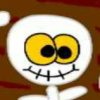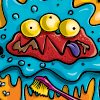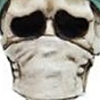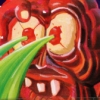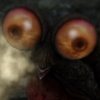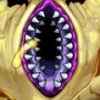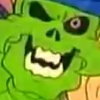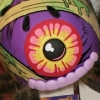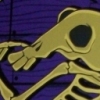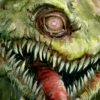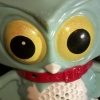Written by Jonathan Wojcik

I've never been too eager to really experience the time consuming, expensive hobby of miniature gaming first-hand, but like many other gaming worlds out there, the settings of Warhammer and especially Warhammer 40,000 have always been fun to admire from afar, especially when your sense of what's funny and adorable is indistinguishable from what a really angry twelve year old considers hardcore. Indeed, 40k is a bit infamous both in and out of its own fandom for its humorously excessive morbidity, actually spawning the term "grimdark" to describe its universe of skull-ravaging, blood-barfing, genocidal demon armies who totally don't listen to almost anybody's mom...sometimes not even their own!
From deranged cults of rat people to parasitic colonial space bugs, there's a veritable butt-ton of imaginatively absurd lore from across this ludicrous canon, but only one specific faction I can really identify with on a personal enough level to bother yammering about for any length of time, and if you've any familiarity with its mythos yourself - or you've been reading my blog - you've probably already guessed which one that is.
Bogleech Reviews NURGLE STUFF

Significant to both the "death metal with swords" and "death metal in space" ends of battlemallets is the concept of the Immaterium or Warp, a dimension of whatever you want to think "psychic energy" or "pure chaos" are actually supposed to mean and the home of the Chaos Gods, horrible entities born from the collective subconscious of life throughout the universe. Among these are satans like Slaanesh: the God of Tentacles Going Into Butts, Corn: the Murder Death King of Dying, and That Other One: Pretty Cool But Not The Best One. Finally, we have Nurgle: The Best One. Cementing his official title that I didn't make up, Nurgle is the one who has all the green slime and bugs, and of all the stuff I'm aware of in Hamwars - barring maybe the Space Orks - Nurgle is also the gosh-darn cutest, as we shall see.

It's important (I'm told) to note that the Chaos Gods and their various realms may or may not be actual, literal, physical entities at all, but malevolent, abstract concepts that can sometimes whatever, I don't care. Residing in a great, festering, stagnant "garden," Nurgle is said to be a giant, bloated, rotten sack of worm-ridden filth responsible for the processes of decomposition, the evolution of parasitism and the existence of infectious pathogens all throughout the various layers of reality, always cooking up new poxes and vermin in his giant, bubbling cauldron of scum.
Of course, it may have occurred to the ecologically minded among you that parasites, diseases and decomposers actually constitute most of all life as we know it, and the life that doesn't fall under those categories would not and could not exist without them. These facts were not lost upon the authors of Warhammer canon, because while Nurgle is often misunderstood as only the god of destruction and death, he is first and foremost the god of prosperity, survival and life, seeing as he perpetuates it in only its most abundant and successful forms.

Appropriately for a being that fills our universe with just so much life, Nurgle is far from some cold, heartless cosmic abomination brooding upon a mountain of decaying corpses. No, Nurgle is a joyful, fun-loving cosmic abomination laughing at his farts upon a mountain of decaying corpses. Even referred to by his underlings as "Papa" Nurgle, he lavishes affection upon his myriad contagions and shambling minions, who in turn regard one another as all part of the same vast, deeply connected family; a family that embraces oneness with the circle of life and celebrates biodiversity as one only can by becoming the willing food source and breeding ground for so many other, more prolific organisms. Work for Nurgle, and you'll probably be treated better than almost any other option the 40k universe has to offer.
The story does, however, admittedly grow a bit darker - sorry, grimdarker - with the in-universe legend of the goddess Isha. Whether or not she literally exists within the game's canon is up to fan interpretation, but the Eldar, which are like moon elves or something, are convinced that their own deity of life and fertility is a prisoner of Nurgle, who expresses his love for her by keeping her in a little cage next to the giant cauldron he supposedly brews all his diseases in, and making her taste them to see if they're ripe enough. More or less resigned to her fate, she's said to take advantage of her insider info and bestow mortals with the medical knowledge to counteract Nurgle's efforts and maintain the balance.

None of this elaborate backstory ever factors directly into playing a Werehomer game, but it does give a lot of fun context to those funny little toys people push around, and every monster you can add to your army comes with its own amusing lore. To start off with the lowest-level fiends, the tiny Nurglings or "mites of Nurgle" are dirty little imps who frequently hatch from the boils, tumors and gangrenous wounds of bigger, even dirtier monsters, tunneling around in the rotten entrails of their fellow demons. Fortunately, their big brothers and sisters not only don't mind, but enjoy their company the way we would enjoy a gaggle of friendly, hilarious baby monkeys. Nurglings even go out of their way to make themselves useful or at least entertaining to their hosts, and compete for affection by collecting "presents" for their larger companions, or bringing them whatever it is they think is helpful.

Larger and much more intimidating are the Great Unclean Ones, said to closely resemble Nurgle himself and devoted to spreading his diseases throughout the cosmos. As terrifying as these guys look, they're every bit as fatherly and jovial as the daemon god himself, motivating their many demons, ghouls and diseased human subordinates with kindness and encouragement. To a Great Unclean One, every last Nurgling under its command is like its own child. This is a rotting, demonic master who cares. One who cares even more about the well being and happiness of its underlings than it cares about itself. I don't know why that's so incredibly uncommon among serious fantasy villains, because we all know positive reinforcement is highly effective and breeds the kind of loyalty so many maniacal overlords could have really used in their hour of need.

A few Unclean Ones even get their own unique stories, like Ku'gath, the Plaguefather, originally a Nurgling who was bouncing around while Nurgle brewed his all-time greatest, most potent, once-in-an-eternity superbug. Accidentally falling into the vat, Ku'gath absorbed it all and instantly became one of the biggest and toughest Great Unclean Ones. The cute twist here is that Nurgle found this completely entertaining and cool, but Ku'gath felt so bad for ruining that ultimate concoction, he's never stopped trying to perfect it again - and never stopped being one of the gloomiest, orneriest members of the otherwise jolly cult.

Rounding out the three primary flavors of Nurgle daemon, the Plaguebearers are only a little larger than a human or two, and in fact, tend to be created from the horribly mutated bodies of humans afflicted with Nurgles "favorite" disease, simply known as Nurgle's Rot. This could explain why their personalities differ so much from the mischievous, carefree Nurglings and easygoing Unclean Ones, as Plaguebearers are weirdly obsessed with organization and especially counting. Like a Chinese vampire or a muppet, these guys are just constantly rattling off numbers as they count diseases, maggots, slaughtered enemies, basically whatever's around that they think needs to be counted. Off the battlefield, they serve as more or less the accountants of Nurgle's forces, whether or not anybody actually asked, needed, or wanted someone to catalog and file their different kinds of boils, and as demons of the ever-shifting chaos realm, they constantly have to start over anyway.

By far the cutest and most heartbreaking of all Nurgle's children, however, are his Beasts, seen here in one of their earliest official miniatures, a bug-faced fiend I vastly prefer over the more reptilian, more savage looking models they seem to be producing these days. Slug-bodied, taloned, fanged and tentacled, the beast is a nigh-unstoppable engine of murder on the battlefield only because its disposition is said to be that of a perpetually frisky puppy. Ever have a huge dog so ecstatic to see you that it effectively pile-drives you to the floor, incapable of understanding relative size and scale? That's the Beast of Nurgle, except its every pore is also oozing pure biohazard, and it leaks its own lethally caustic mucus whenever it's excited and happy, which is literally all the time. Its official descriptions even talk about it wagging its tail, rolling over for belly-rubs and bouncing around for attention.
So, Beasts of Nurgle are just mildly annoying to their fellow pox-monsters at worst, but when unleashed on an enemy army, they try to "play" with one new "friend" after another until, for some reason, they stop moving, but luckily there's almost always someone else in sight who apparently wants to play chase...and that's the beast's very most favoritest game!

The other most heartbreaking Nurgle thing, meanwhile, is the rot fly. Used as steeds by plaguebearers, these gorgeous giant insects are nicely reminiscent of Beelzebub's popular depictions, though I still feel the need to mention that proper flies only have one pair of flight wings, while the rear pair are reduced to tiny knobs called halteres. In any case, I especially like this hose-mouthed option, between an actual fly's face and a gas mask.
So why heartbreaking? Well, apparently, not all Beasts of Nurgle stay carefree and playful forever. Over the eons, some of them even start to feel sad, because everyone they play with just falls apart and rots like a giant asshole. Wondering why nobody wants to be their friend, they grow increasingly bitter and angry even as they continue to desperately lavish affection upon every stranger.

The final straw comes when a Beast at its most scorned is finally killed in battle by someone it was trying to befriend. Its body returns to the "warp," that "pure psychic dimension" mumbo jumbo I mentioned way back, and its hurt feelings initiate a metamorphosis into an entirely different monster, sleek and taloned and winged. The new Rot Fly eventually comes roaring back to material reality with hate in its heart and revenge on the brain, but hate and revenge still driven by the fact that nobody would play with it. Oh my god. Oh my god that's so sad and precious and hilarious. This game has brilliant writing, even if it's not the same kind of brilliant some of its hardcore, serious fandom seems to believe.
The best part of the Rot Fly's revenge? Its primary method of attack is actually to tear off a person's head, apparently emitting "mean spirited laughter" the entire time, swallow it and keep it in its festering, demonic insect guts until it's ready to vomit back up as a "death's head;" a half-digested skull so ripe with contagious biota that it's essentially a germ grenade. Oh yeah, and if a Rot Fly finds the specific person who killed it back when it was a Beast, it just swallows them whole and keeps them alive forever in its putrescent innards. Because it just wanted a friend, you shitty bastard.

No Warhammer faction is complete without excessively armored, gun-toting soldiers, though as the most human of Nurgle's cult, the "plague marines" are even bigger sticks in the mud than those salaryman plaguebearers. Humans in the Warhammer universe are as petty, violent, selfish and hateful as they are in the real world, but with even more excessive firepower. You could say 40,000 times the firepower. From the sound of things, these guys often miss the point of Nurgle's adoration for all life and just want to blow shit up, but that's okay, Nurgle doesn't judge. Blowing shit up just means another mass explosion of maggots, flies, carrion beetles, worms, rodents and vultures, so it's all good. People who pledge themselves to the demon of rot get a pretty sweet deal out of it, too; they can live indefinitely, and despite all the worms tunneling through their skin and the mildew pouring out of their eye sockets, they never feel pain or even minor discomfort ever again. Being a bloated sack of vermin apparently feels great to a follower of Nurgle.

One more monster I'd like to mention is one of my favorite designs after the Rot Flies and the old-school Beasts, and that's the plague toad. Unfortunately, these things don't come with any cute, lighthearted background story. Though canon, they're sold under the Forgeworld miniatures label, and don't even really get much of their own unique, special gameplay function; you're just free to use them for whatever modeling purposes you want, like a stand-in or even a mount for other figures.

It's too bad, because the plague toad miniatures themselves are freaking beautiful. Look at all those warts and scabs and gaping pores! The lopsided faces on blobby frog bodies! The giant mouths full of snaggly human-like teeth! The only storyline I have seen written for these things suggests they're either mutated nurglings or plaguebearers "punished" by Nurgle for failing him. That's not even something Nurgle would do. That completely misses the point! How about this: sometimes a very old, very special Nurgling is so overcome with protective, paternal instincts that it begins to absorb other Nurglings into its body, eventually forming a dense, sticky cocoon and hatching into a Plague Toad, a motherly monster whose sole purpose is to perpetuate and nurture the slimy mites. Constantly brooding the little guys in its blisters - like the coolest real-world toad - it chases down and swallows prey whole only to regurgitate their weight in even more Nurglings, vaguely aware of what they used to be but completely devoted to their new mom.

Another great Forgeworld contribution is the "Blight Drone," and while similarly stingy in the plot department and short on humor, I like when a "machine" gets to be a grody monstrosity, and this thing is pretty much just a huge, diabolical mutant maggot with a rusty hovercraft for a hat. I also appreciate how this sample model on their website has it constantly defecating as part of its base. I'd be way more into vehicles and robots if they defecated more.

There's a lot of other Nurgle material out there, especially when we get into the tabletop role-playing game, where we even get to learn more about the various spin-off cults, cultural practices and whole planets taken over by his forces, like the "writhing world" where living citadels wade through seas of wormy tendrils and "huskmen" augment their bodies with the remains of giant, dead insects. I didn't even know most of this stuff until I set out to write what was going to be a rather shorter, simpler post on it. From a lot of the online fan presence, you would think Harmwarrers 5000 is all grim, depressing melodrama, all the time. Some of them don't even enjoy the more overtly comedic Orks. From some parts of the fandom you might even think it was some sort of testosterone-addled, fascist pro-war propaganda, even though the whole thing is more or less one giant, satirical middle finger towards that whole mindset.

ART BY LESHIY!
On the outside, Nurgle and his allies look like they should hit on every cliche of the most disgusting, obscenely evil undead villains, but they only subvert all expectations with their sense of camaraderie and love of nature. Is there even any downside at all to joining their ranks? You can live forever, you never feel pain again, diseases are pleasurable and your giant, pestilent boss actually cares about and respects you. What's there to lose? Thehumans of the 40k universe tend to be xenophobic, genocidal, evangelical tyrants, so basically the same shit we already have to put up with in the real world.
We could really use some more Nurgle around here.

Halloween 2014 Archive:
